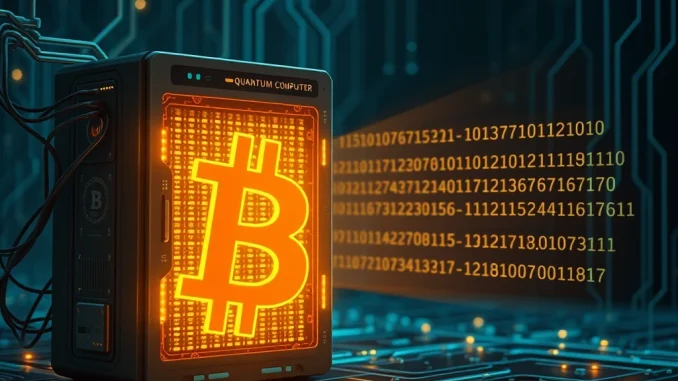
Hold onto your crypto keys! A fascinating, and slightly alarming, challenge has emerged from the quantum computing realm. Project Eleven, a firm specializing in quantum technology, has thrown down the gauntlet, offering a hefty 1 Bitcoin prize. Their mission? To crack Bitcoin’s vaunted elliptic curve cryptography using the immense power of a quantum computer within a year. This isn’t just a theoretical exercise; it’s a very real test of the ‘Quantum Day’ (Q-Day) threat looming over the cryptocurrency world. Let’s dive into what this means for your Bitcoin and the broader crypto landscape.
The Intriguing Q-Day Prize: Testing Bitcoin Security
Project Eleven’s “Q-Day Prize” is designed to directly confront the growing concern of quantum computing threat to existing encryption methods. But why is this important, and what exactly is the threat?
- Quantum computers possess the potential to perform calculations at speeds exponentially faster than classical computers for certain types of problems.
- This computational leap could potentially break current encryption algorithms, including the Elliptic Curve Digital Signature Algorithm (ECDSA) that secures Bitcoin encryption.
- Project Eleven’s challenge is a practical experiment to gauge how far along quantum computing is in posing a real-world risk to Bitcoin security.
- The prize, 1 Bitcoin, while symbolic in the grand scheme of crypto value, represents a significant incentive to researchers and developers in the quantum computing field to focus on this specific challenge.
Why is Bitcoin Encryption Under Scrutiny?
Bitcoin, like many cryptocurrencies, relies on robust cryptography to secure transactions and protect digital assets. The current encryption method, ECDSA, is considered highly secure against traditional computing attacks. However, the rise of quantum computing introduces a new paradigm. Here’s a breakdown of why Bitcoin encryption is now being scrutinized:
| Aspect | Traditional Computing Era | Quantum Computing Era |
|---|---|---|
| Encryption Method | Elliptic Curve Digital Signature Algorithm (ECDSA) | ECDSA (Potentially Vulnerable) |
| Computational Power | Limited to classical algorithms | Exponentially increased for specific algorithms (like Shor’s algorithm relevant to ECDSA) |
| Security Level | Considered highly secure | Potentially compromised by quantum attacks |
| Threat Level to Bitcoin | Negligible | Potentially significant in the future |
As the table illustrates, the shift to the quantum computing era could fundamentally alter the security landscape for Bitcoin and other cryptocurrencies. The core issue revolves around algorithms like Shor’s algorithm, which, when run on a sufficiently powerful quantum computer, could theoretically break ECDSA.
The Alarming Stakes: Millions of BTC at Risk?
The report cited by The Block highlights a potentially staggering figure: over 6.2 million BTC could be vulnerable if Bitcoin security is compromised. To put this into perspective:
- 6.2 million BTC represents a significant portion of the total Bitcoin supply.
- At current valuations, this amount translates to hundreds of billions of dollars worth of cryptocurrency at risk.
- This vulnerability isn’t just about losing coins; it could severely damage trust in Bitcoin and the entire cryptocurrency ecosystem.
- The challenge by Project Eleven underscores the urgency of understanding and mitigating this potential crypto vulnerability.
While the immediate threat might be debated, the long-term implications are undeniable. The cryptocurrency community and developers need to proactively address the potential risks posed by quantum computing.
Is Your Bitcoin Really in Danger Right Now?
While the “Q-Day Prize” and the 6.2 million BTC figure sound alarming, it’s crucial to maintain perspective. Is your Bitcoin at risk of being stolen by a quantum computer today? Probably not. Here’s why:
- Quantum computers are still in their nascent stages. Building a quantum computer powerful enough to break Bitcoin’s encryption is a monumental technological challenge that is likely still years away.
- ECDSA is still robust against classical attacks. Your Bitcoin is still very secure against traditional hacking methods.
- Bitcoin developers are aware of the quantum threat. Research and development are already underway to explore quantum-resistant cryptographic algorithms for Bitcoin.
- The one-year timeframe of the Q-Day Prize is likely symbolic. It’s highly improbable that anyone will break Bitcoin’s encryption within a year using a quantum computer. The prize is more about raising awareness and incentivizing research than expecting an immediate breakthrough.
However, complacency is not an option. The challenge from Project Eleven serves as a vital wake-up call. The cryptocurrency world needs to prepare for a future where quantum computers are a reality.
What Can Be Done to Fortify Bitcoin Against Quantum Threats?
The good news is that the cryptographic community isn’t standing still. Several potential solutions are being explored to enhance Bitcoin security against quantum computing:
- Quantum-Resistant Cryptography: Developing and implementing new cryptographic algorithms that are resistant to attacks from both classical and quantum computers. This is a long-term solution that requires significant research and standardization.
- Post-Quantum Cryptography Migration: Planning and executing a transition from ECDSA to a quantum-resistant algorithm within the Bitcoin protocol. This is a complex undertaking that would require broad community consensus and careful execution to avoid disruptions.
- Hybrid Approaches: Combining existing ECDSA with quantum-resistant methods to provide an interim layer of security while fully quantum-resistant solutions are developed and implemented.
- Increased Key Randomness and Security Practices: While not a direct solution to quantum attacks, improving overall key management practices and randomness generation can make any cryptographic system more resilient.
Actionable Insights: Staying Ahead of the Quantum Curve
While you don’t need to panic and sell all your Bitcoin, it’s wise to stay informed and proactive. Here are some actionable insights:
- Stay Informed: Keep up-to-date with news and developments regarding quantum computing and its potential impact on cryptocurrencies. Reputable crypto news sources and research publications are good resources.
- Support Development Efforts: Recognize and support initiatives focused on developing and implementing quantum-resistant cryptography in Bitcoin and other cryptocurrencies.
- Educate Others: Spread awareness about the potential quantum threat and the importance of proactive measures within the crypto community.
- Long-Term Perspective: Understand that the quantum threat is a long-term challenge. Solutions will likely emerge over time, and the cryptocurrency ecosystem is adaptable.
Conclusion: A Proactive Stance on Bitcoin’s Quantum Future
Project Eleven’s “Q-Day Prize” is more than just a publicity stunt; it’s a crucial catalyst for focusing attention on the long-term quantum computing threat to Bitcoin security. While the immediate risk is low, the potential for future vulnerability is real. The challenge serves as an urgent reminder that the cryptocurrency world must proactively prepare for the quantum era. By staying informed, supporting development efforts, and maintaining a long-term perspective, the Bitcoin community can navigate this challenge and ensure the continued security and resilience of the world’s leading cryptocurrency. The race to quantum-proof Bitcoin is on, and it’s a race we all need to watch closely.



